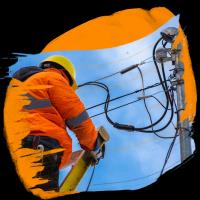 Add My Company
Add My Company
Sign In

Sparks & Ladders: How To Stay Safe When Using Ladders Near Electricity
HOW TO STAY SAFE WHEN USING LADDERS NEAR ELECTRICITY
Ladders are essential pieces of equipment for many tradesmen and maintenance workers, but they are also one of the most dangerous.
Data from the Health and Safety Executive (HSE) highlights that each year, around 1000 people suffer electric shock-related injuries, with around 30 of those proving fatal. The vast majority of these fatalities are the result of contact with overhead or underground power cables, with ladders the primary cause.
This illustrates the point that ladders and electricity are a potentially deadly combination. Employers and workers, therefore, need to be aware of the risks of using ladders around power lines and take precautions to protect themselves.
COMMON JOBS INVOLVING POWER LINES
Several occupations involve working with ladders close to power lines. These workers should be provided with risk assessment training and appropriate safety equipment.
The occupations most at risk include:
Firefighters
Linesmen
Telecommunications workers
Maintenance electrician
Installation electrician
CCTV installers
Rail workers
Construction workers
Roofing contractors
Crane drivers
Scaffolders
Painters and decorators
Arboriculturalists
Landscape gardeners
TV Aerial installers
Street light contractors
Along with the above occupations, members of the public are also at risk of injury when carrying out DIY tasks such as cleaning gutters, carrying out roof repairs and installing decorative lights.
ALUMINIUM VS WOOD VS FIBREGLASS
The material and construction of the ladder play a major role in the survivability of an electric shock due to accidental contact with overhead power lines. Most commercial ladders are made from either aluminium, wood or fibreglass.
Each material has its benefits and drawbacks from a safety perspective. Let's look at each material in more detail to get a better idea of its suitability for working close to overhead power lines.
SAFETY RISKS
Each year 20 people are killed and more than 400 are injured after coming into contact with overhead power lines. The risks of working close to electricity are real, but they are not immediately obvious. Many workers are simply not aware or forget that power lines are overhead.
So in this section, we will look at the different types of power lines and the risks associated with them. This will give you a better understanding of the potential for getting a shock.
The highest voltage power lines in the UK carry between 275kV and 400kV. These transmission lines are operated by the National Grid and distribute power across the UK. The minimum height of these power lines is 7m for 275kV and 7.3m for 400kV.
This is outside the operational height of most extension ladders, so the risk of accidental contact is low. But they still present risks to crane and platform operators, so care should be taken when using this type of equipment.
Distribution lines bring electricity into towns and cities. They carry 132 kV and are operated by the Distribution Network Operator. The minimum height for this type of power line is 6.7m.
While these lines are beyond the operating height of extension ladders, there is the risk of an induced voltage when using aluminium ladders. So extra care should be taken when working around this type of power line.
Smaller distribution lines distribute power within towns and cities. They carry between 11 kV and 33 kV. The minimum height for this type of power line is 5.2m. This is within the operating height of some extension ladders.
Most accidental contact with power lines occurs with this type of distribution line. So when working within the proximity of such lines a thorough risk assessment should be carried out to identify the dangers and mitigate against them.
SAFETY TIPS
When working near power lines, the following safety tips should be deployed to reduce the risk of electric shock:
For more information on Sparks & Ladders: How To Stay Safe When Using Ladders Near Electricity talk to Ramsay Ladders
Enquire Now
List your company on FindTheNeedle.

